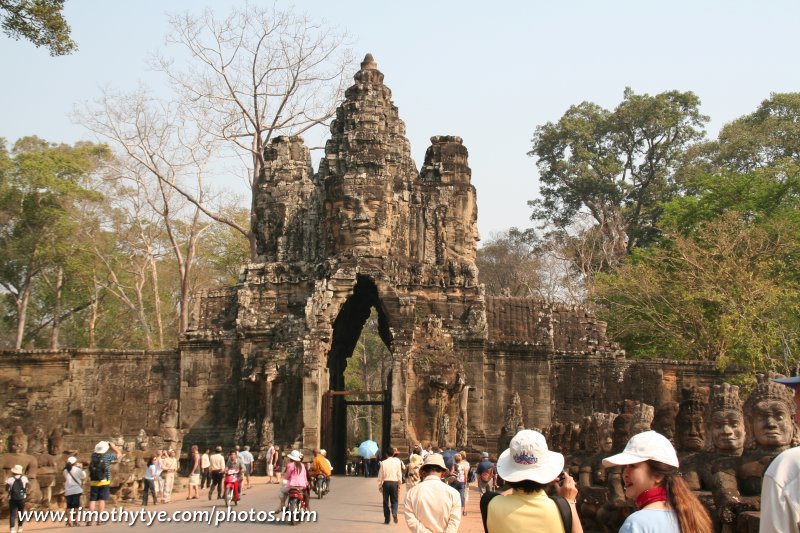 South Gopura, the main gateway for most tourists into Angkor Thom (1 March 2008)
South Gopura, the main gateway for most tourists into Angkor Thom (1 March 2008)
Angkor Thom អង្គរធំ (GPS: 13.43345, 103.86199) is the great ancient city of the Khmers. It even cover an area larger than Angkor Wat. However, unlike Angkor Wat, which is one big temple complex, Angkor Thom comprises over a dozen different temples, each built during a different period by different Khmer kings. The best known ruin at Angkor Thom include the Bayon, Baphuon and Phimeanakas. Also located within Angkor Thom are the Terrace of the Elephant and the Terrace of the Leper King, the Prasat Suor Prat, and many other ruins.
360° View of Angkor Thom on Google Maps Street View
The name that we know of this city, "Angkor Thom", is not what the ancient Khmer called the city. However, it has been known as such since the 16th century. And it's an appropriate name too, for Angkor Thom means "Great City".
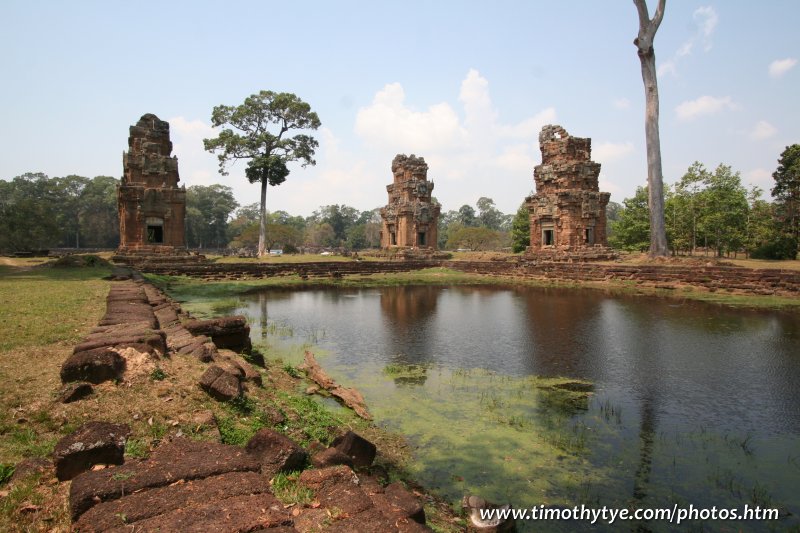 The serene surroundings of Prasat Suor Prat and its pond at Angkor Thom (26 February 2006)
The serene surroundings of Prasat Suor Prat and its pond at Angkor Thom (26 February 2006)
Most of the structures in Angkor Thom were constructed during the reign of King Jayavarman VII, who used up so much resources (in terms of good quality stones and building material) that subsequent kings no longer was capable of building at a similar scale as he did. In fact, the entire Angkor civilization went on a gradual decline after the building boom initiated by Jayavarman VII.
Angkor Thom as been around longer than Jayavarman VII, however. Some of the ruins within it, such as the Baphuon and Phimeanakas, were constructed earlier than the city itself. The Angkor Thom that we know today, with Bayon at the center, overlaps the southeast corner of an earlier Angkor city built by King Udayadityavarman II that centred around the Baphuon, the first capital of the 9th century kingdom of Yasodharapura.
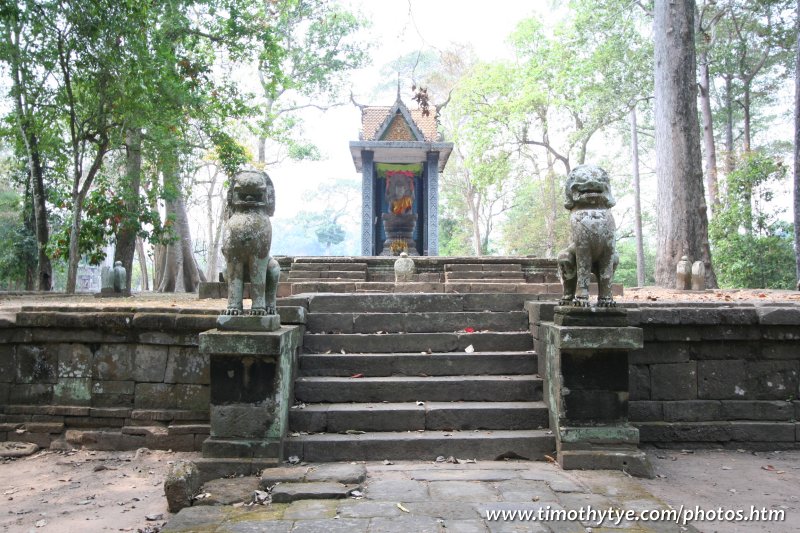 Vihear Prampil Loveng, Angkor Thom (26 February 2006)
Vihear Prampil Loveng, Angkor Thom (26 February 2006)
When Jayavarman VII decided to make it his capital, he built a protection wall on each side of Angkor Thom. Outside the wall is a moat. The moat is crossed at five places by laterite causeways, four according to the cardinal points of the compass, and the fifth, known as the Victory Gate, leads from the Royal Square of Angkor Thom.
Everything at Angkor Thom was built on gigantic proportions. Each side of Angkor Thom measures 3km (1.8 miles). The moat is 100 meters (328 ft) wide and 6 meters (20 ft) deep.
At each corner of Angkor Thom is a small chapel called Prasat Chrung. These chapels each contained a stone inscription (or stellae) documenting the construction of the city. In the ancient times, there was another 40 meter (130 ft) canal about 100 meters from the walls with a road running along its side, for soldiers to move about and for ritual circumabulation of the city.
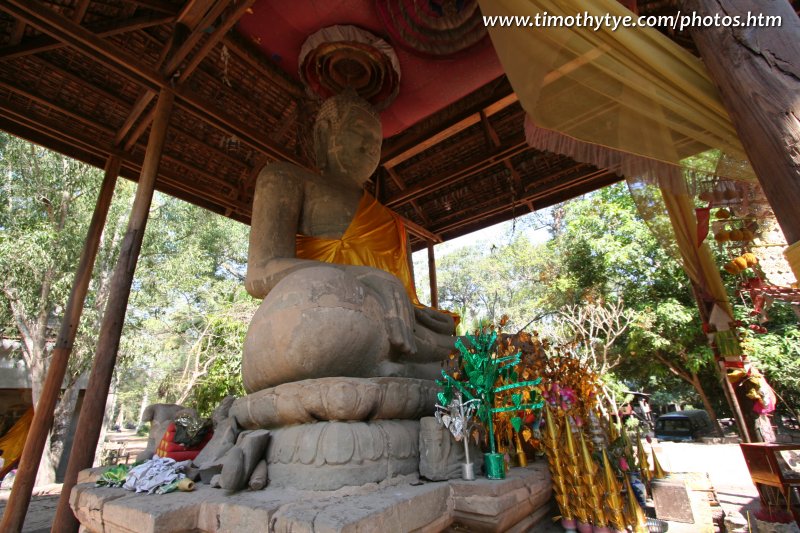 Tep Pranam, a huge Buddha image at Angkor Thom (25 February 2006)
Tep Pranam, a huge Buddha image at Angkor Thom (25 February 2006)
The causeways into Angkor Thom are lined with statues of gods (devas) and demons (asuras). They are tugging on a giant serpent (naga), recreating the scene from "Churning the Ocean of Milk" in Mahabharata, a recurring subject in ancient Khmer art which we also see in bas-relief in Angkor Wat. But here, the scene is in three dimension, with the gods on one side of the causeway and the demons on the other.
The focal point of the tugging scene is the state temple of Bayon, located right at the heart of Angkor Thom, representing Mount Mandara (or Mount Meru), the pivot of the churning scene. Hence, to the observed eye, the construction of Angkor Thom is pregnant with symbolism.
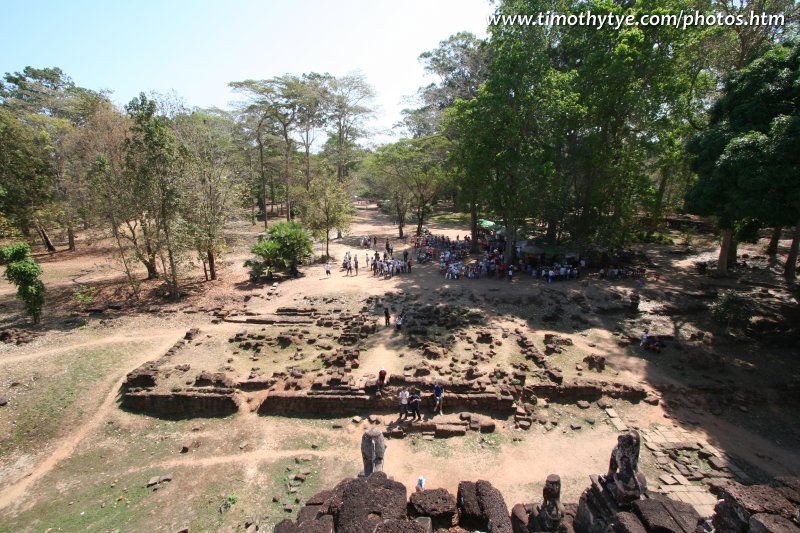 View of the Royal Palace grounds of Angkor Thom from the top of Phimeanakas (25 February 2006)
View of the Royal Palace grounds of Angkor Thom from the top of Phimeanakas (25 February 2006)
The causeways lead to the soaring gateway of Angkor Thom. These gates, called gopura, are 75 feet tall, and are topped by the giant stone faces of the bodhisattva Avalokitesvara, with whom King Jayavarman VII identified himself, facing in the four cardinal directions.
The South Gopura is the most popular among visitors, and if you are coming from the direction of Angkor Wat - as most visitors do - this is the first instance that you see Angkor Thom. The two other gateways in constant use today are the Victory Gopura and the North Gopura. The remaining two gateways, the East Gate and West Gate are not often visited but anybody but serious Angkor enthusiasts.
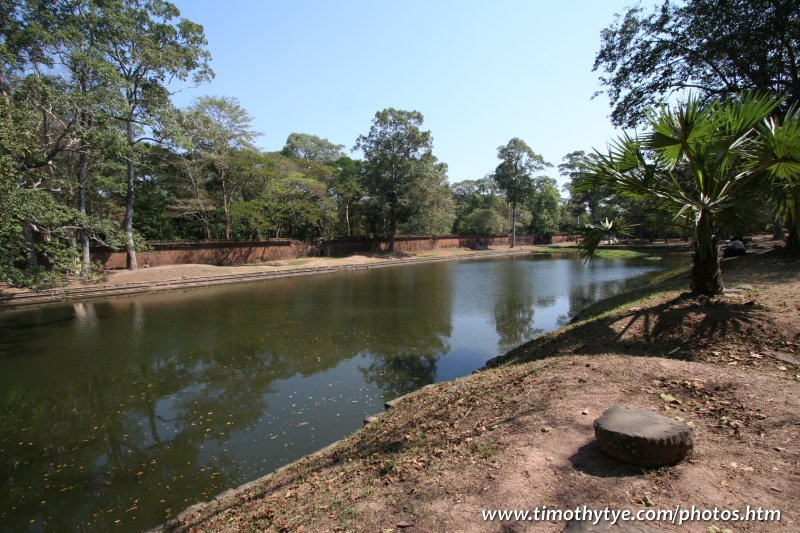 The Large Pond within the Royal Palace ground of Angkor Thom (25 February 2006)
The Large Pond within the Royal Palace ground of Angkor Thom (25 February 2006)
Angkor Thom is  in the centre of the Map of Angkor
in the centre of the Map of Angkor
Sights within Angkor Thom
Upon entering Angkor Thom, you will arrive at all the following sights. To visit all of them will require a full day or even more. Let me list them here, in alphabetical order. I mark ( * ) for sights I deem to be of considerable interest and ( * * ) for sights of major interest.In addition to the individual ruins, you might also want to explore the different gates of Angkor Thom. I have documented all five of them below. Of these, the most commonly used is the South Gate.
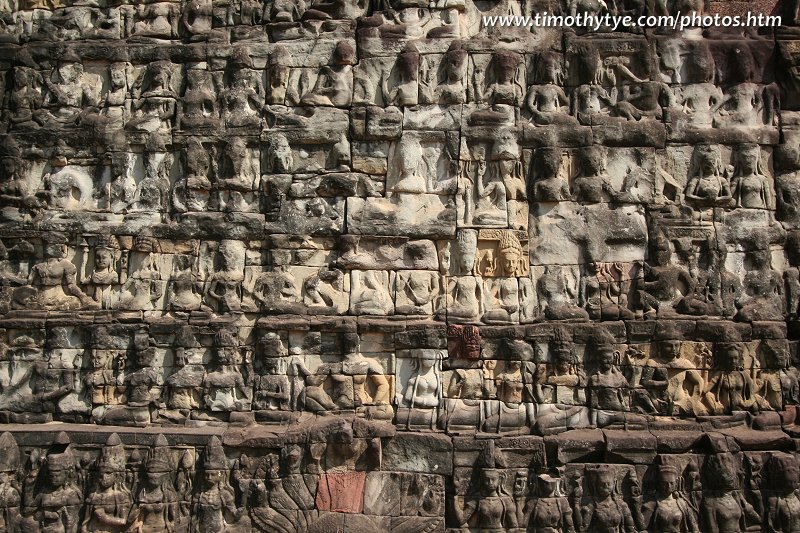 A restored multi-tier relief of the Terrace of the Elephants at Angkor Thom (25 February 2006)
A restored multi-tier relief of the Terrace of the Elephants at Angkor Thom (25 February 2006)
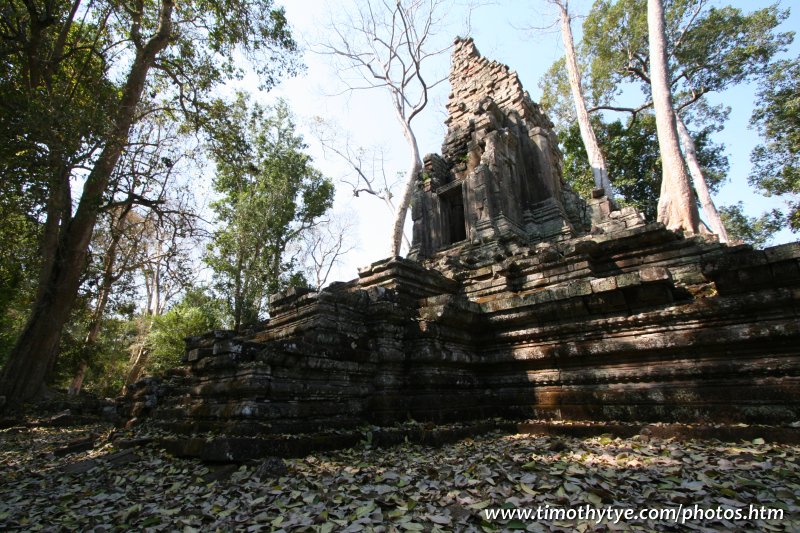 Preah Palilay, Angkor Thom (25 February 2006)
Preah Palilay, Angkor Thom (25 February 2006)
Angkor Thom In Brief
Period: Angkor Thom proper including its walls, moats and causeways was built by Jayavarman VII in the late 12th century, together with the Bayon. Other monuments of this period include Ta Prohm, Banteay Kdei, Preah Khan, Neak Pean, Ta Som, Srah Srang, Ta Nei and Ta Prohm Kel. Monuments within Angkor Thom built by earlier rulers include the Baphuon and Phimeanakas.Getting there
Angkor Thom is usually entered through the South Gopura, which is 1.7km north of the western entrance of Angkor Wat. Angkor Thom can also be approached through the North Gopura, which is 1.6km from Preah Khan, and by the Victory Gopura, which is 1km to the west from Ta Keo.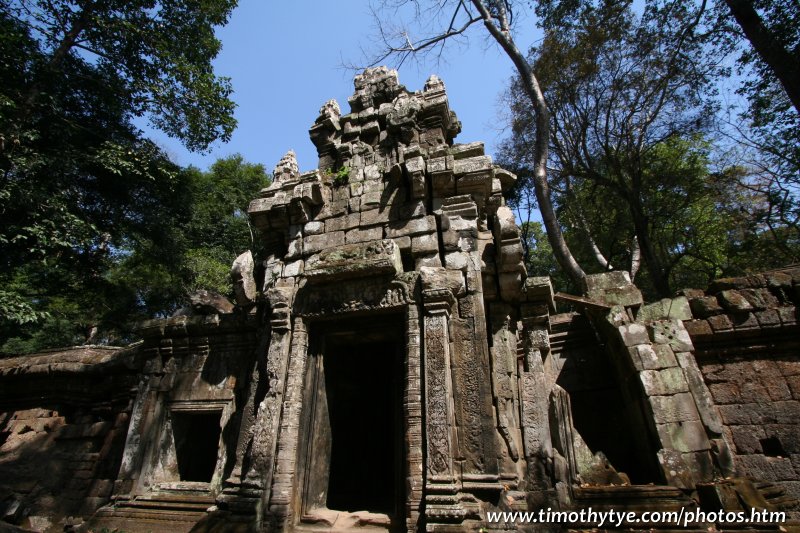
The southern side entrance to the Royal Palace of Angkor Thom (25 February 2006)

 Latest updates on Penang Travel Tips
Latest updates on Penang Travel Tips
 Map of Roads in Penang
Map of Roads in Penang
Looking for information on Penang? Use this Map of Roads in Penang to zoom in on information about Penang, brought to you road by road.
Copyright © 2003-2025 Timothy Tye. All Rights Reserved.

 Go Back
Go Back *
*
 * *
* *



 *
*

 *
*

 *
*








